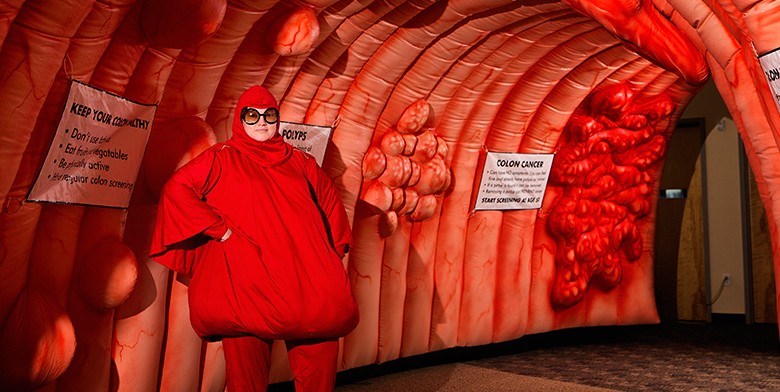March is Colorectal Cancer Awareness Month: Demystifying the colonoscopy
February 26, 2018
March is Colorectal Cancer Awareness Month; colorectal cancer is one of the most frequently diagnosed cancers among Alaska Native people. To help shed some light on the colonoscopy cancer screening procedure, ANTHC is republishing a story from our archives that can also be found in the current issue of the Mukluk Telegraph.
Health care professionals and survivors say embarrassment is no excuse for skipping the screening that could save your life
Jake Martus has heard every excuse.
As a patient navigator at Alaska Native Medical Center, he’s responsible for scheduling colonoscopies, doing outreach to potential high risk groups and educating patients about the procedure.
“They’ll say they’re ‘too busy,’ ‘have too much work,’ ‘can’t get a babysitter,’ ‘can’t find an escort to come with’ — anything to get out of coming in for a colonoscopy,” Martus said. “What I do is try to figure out what their barriers are, eliminate misconceptions and encourage them as much as I can.”
Recognizing risk factors
In the U.S., March is National Colorectal Cancer Awareness Month. According to the National Institutes of Health’s National Cancer Institute, 2015 saw an estimated 132,700 new diagnoses of colorectal cancer, which comprised 8 percent of all new cancer cases in the U.S. An estimated 49,700 people died from the disease in 2016.
Though the median age of diagnosis is 68, Martus said it’s important for Alaska Native people to start getting colonoscopies at age 40, since there is a higher rate of diagnosis among the Alaska Native population.
“There are factors, like age and where you live, that you don’t have much control over,” Martus said. “But there are contributing risk factors for the disease that you can control. Alcohol, tobacco, being inactive, obesity, diabetes — things like that you can manage to help reduce your likelihood.”
Martus explains that colorectal cancer often begins as a growth called a polyp, which can grow on the inner wall of the colon or rectum. Over time, some of these polyps may become cancerous. Colonoscopies search for and remove these polyps.
Overcoming embarrassment
Don Torgramsen wasn’t thrilled about the idea of getting a colonoscopy. But when he started having irregular bowel movements, he thought it was time to go see a doctor.
“You know, it’s a man thing,” Torgramsen said. “It’s kind of embarrassing, and the thought that something could be wrong can be scary.” Torgramsen said though he was fearful about the procedure, it was easier than expected.
“Really, the prep work is the hardest part,” Martus said. “The actual procedure is very quick.”
Colonoscopy exams start with a preoperative appointment in which a provider evaluates whether a patient is healthy enough. Once a patient has been cleared, a certified medical assistant will educate them about what to expect from the procedure. The day prior to their colonoscopy, patients need to stick to as close to a clear liquid diet as possible (definitely no red food coloring, though, lest the doctor mistake it for blood during the exam), take prescription medications and drink a specially formulated beverage to clear their bowels.
The day of the exam, patients will be given an IV of medications to induce a drowsy, relaxed feeling. Once ready, they’ll lie on their left side on the exam table and a doctor will insert a colonoscope — a flexible, tubular instrument, about a half-inch in diameter, that transmits an image of the colon — into the rectum to look for abnormalities. The scope bends as it is moved around the curve in the patient’s colon. The scope also blows puffs of air to help expand the colon for the doctor to see better.
Martus said sometimes patients feel mild cramping, but otherwise the medications do their job to minimize pain.
“It’s not too bad and once it’s over you can go back about your day normally,” Martus said. “You’ll be in and out in a couple hours.”
If any polyps are found, they’ll be removed immediately and sent to be screened to determine if they are precancerous.
Screening saves lives
Torgramsen said he was lucky to have gone in when he did — during his procedure the doctor found five polyps.
“If I didn’t go in, I’m not sure where I’d be now,” Torgramsen said. “I’d probably have a lot of problems.”
His procedure and results, Torgramsen said, inspired his brother and friends to have a colonoscopy done as well. Martus said it’s important for everyone — regardless of outward physical health — to get colonoscopies at the recommended age.
“I mean, you could be really healthy, really athletic, never smoke or drink a day in your life,” Martus said. “You could be doing everything you’re supposed to be doing. But I’ve met people like that who have gotten colon cancer at a younger age, too. It’s important to get it done so you don’t have to think about it and you can be around for your family members. Screening saves lives.”
